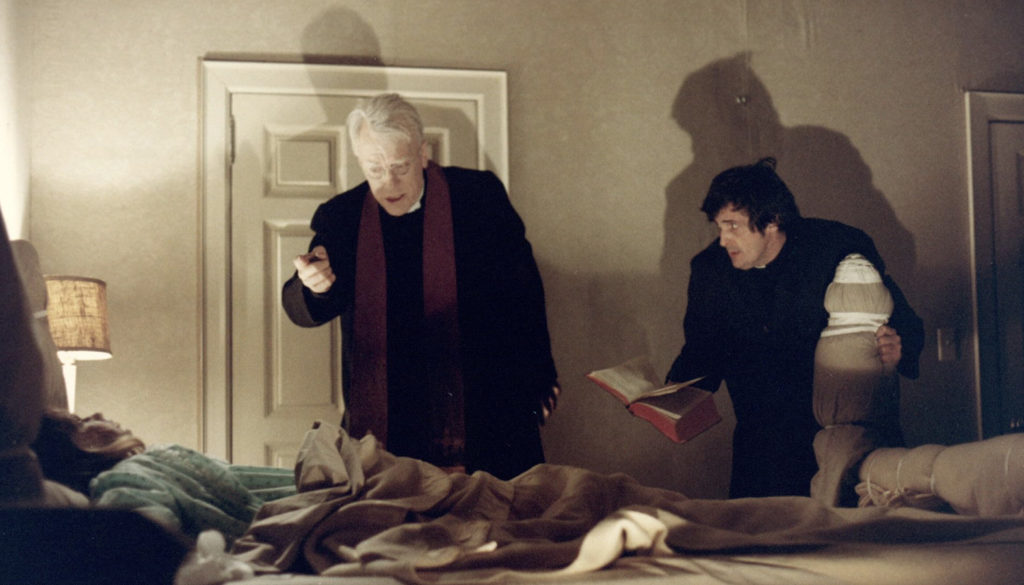If you expect to find solid Catholic teaching in your popular entertainment, you are setting yourself up for bitter disappointment. Between blatant untruths about the faith to grotesque distortions of Catholic facts, entertainment across a wide spectrum has a wretched track record.
This is certainly true when it comes to representations of the devil or demonic spirits. Just how far popular culture has moved from the reality of evil and the devil himself is demonstrated in the recently demised “drama/comedy” television series that had Satan as its protagonist. When you add the panoply of films and TV shows about possessed dolls, automobiles, and every other kind of inanimate object, you get a lot of fire and heat, but very little light.
Even angels are not immune to this kind of entertainment malpractice. When the motivation is benign, like in so many “family” movies or one of the 3,498 Hallmark Christmas movies, angels are still mostly depicted as happy-go-lucky and non-threatening fairy godmother types who help people fall in love or solve a dysfunctional family.
Real angels are a lot different. They often deliver heavy messages directly from God, like you are hereby formally notified to vacate the Garden of Eden, just follow the flaming sword. They also take on tasks not normally found in Hallmark movies or Hallmark cards, like driving Lucifer out of heaven, or bringing a world of hurt onto Sodom and Gomorrah.
Speaking of the Prince of Darkness, there is one supernatural subject that secular entertainment does seem to get right more times than it gets wrong — demonic possession.
I could not read William Peter Blatty’s book, “The Exorcist,” when it was published. When the film came out, I did not see it. The way my tangled mind worked was that if I saw a movie about a giant killer shark munching on Martha’s Vineyard tourists, all I needed to do was stay away from Martha’s Vineyard. The devil is as real as the Book of Genesis, and I did not want to trifle with him in any way.
Eventually, I grew older and stronger in my faith and mustered the courage to watch the film. Mind you, it was 30 years later, and when I did, I watched it on my living room TV in broad daylight and with all the lights on. It was as advertised. A frightening film full of shocks and terror. It was also Catholic to its core in the way the exorcist priest deals with the demon who is torturing his victim.
Twenty years ago, there was another mainstream “possession” film called “The Exorcism of Emily Rose.” Like “The Exorcist,” it was based on a true story about a young woman tormented by a demon and the priest/exorcist who tries to help her. Again, I watched this movie in my living room with all the lights on. The plot was certainly different, with the young woman dying in the exorcism and the priest put on trial for murder. What binds these two films together is the Catholic method of dealing with this supernatural reality.
Now we have the most recent example in the new release, “The Ritual,” starring A-lister Al Pacino. Like its predecessors, it is also based on an actual possession case. It also shares something else: When you need to go head-to-head with the devil himself or one of his minions, secular entertainment never chooses a Unitarian minister or a New Age guru.
“The Ritual” follows this same playbook. The priests — Al Pacino’s old and wise veteran of the Rite of Exorcism, and the younger priest with personal doubts — do combat evil using the tools prescribed by the Church. As nuanced as any of the characters in these films may be, and some have doubts about God or hidden secrets they want to suppress, the actual act of fighting evil with the tools of the Church is constant.
The artistic merits of any of these films aside, they all hinge on the fact that the devil is real and if the conditions are right, he can intercept the spiritual and bodily functions of a victim. It is enough to want to keep your lights on. Thankfully, especially for weak vessels like me, we have Jesus. It is such a simple answer, it seems even popular culture moviemakers can understand it.

